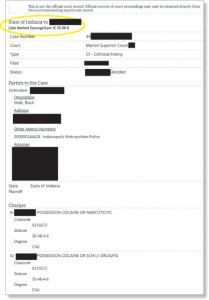Subscriber Benefit
As a subscriber you can listen to articles at work, in the car, or while you work out. Subscribe Now
Asher Waite-Jones picked up on a problem almost right away when he started working at Indiana Legal Services about two years ago.
The first time Waite-Jones went to court was to get an expungement for a client. That client had a high-level felony conviction and hadn’t been to court since they were sentenced 10 years prior.
The expungement was granted, but it fell into the discretionary category, meaning the case wouldn’t be sealed but instead would be “clearly and visibly marked or identified as being expunged,” according to state law.
But Waite-Jones thought there must have been a mistake afterward, because the expungement marking didn’t appear to show up on MyCase. Then he scrolled all the way to the bottom of the chronological case summary and found it there.
Indiana courts weren’t technically doing anything wrong by putting the marking at the bottom, Waite-Jones said, because the discretionary expungements were, in fact, being marked. The problem, he said, was that the markings arguably weren’t clear enough.
Waite-Jones said he even brought up the issue last fall while giving a presentation on expungements at a civil legal aid conference.
“This relief is not easy to get,” he said, “and it’s this big once-in-a-lifetime thing.”
So, Waite-Jones sent a letter earlier this year to the Office of Judicial Administration to bring up the issue of expungement markings.
Now, expunged convictions for felonies that do or don’t involve serious bodily injury — Class C/Level 5 and Class D/Level 6, respectively — are marked as such not only at the bottom of the chronological case summary, but also on the MyCase landing page when you search for a person or case, and at the top of the case page.
‘It was always a problem’
Julie Chambers, a criminal defense attorney in Indianapolis who works on expungements, said she wasn’t aware of the change initially but ran a client’s name through the system to see for herself.
It’s very common for clients to mention the more low-profile expungement marking on their cases, Chambers said.
“It was always a problem,” she said.

Even for someone as experienced as she is, Chambers said she would have to remind herself sometimes to scroll to the bottom of the page on MyCase to look for the expungement.
“It obviously was not very clear,” she said.
Julie Mennel, senior manager of the Expungement Help Desk at Neighborhood Christian Legal Clinic, said one of the unfortunate things about how discretionary expungements were previously marked is that someone browsing MyCase — either on their own or for a more formal background check — may not look closely enough to see the expungement.

The Expungement Help Desk helps pro se petitioners navigate the expungement process. It was established in 2014 in cooperation with the Marion County Prosecutor’s Office, Mennel said, and gets an average of 80 to 90 people who come in during the two walk-in days each week at the Community Justice Campus in Indianapolis.
The help desk has seen about 2,500 people so far this year, she said.
“I do believe that people deserve a second chance,” Mennel said, “so this is just one more way that we can facilitate that for people.”

Indiana passed its Second Chance Law in 2013, allowing people to petition the court for an expungement of criminal records or to seal certain arrests or convictions. A person can only seek expungement of Indiana criminal records once, with a one-year window to file requests in multiple counties.
Having an expungement that isn’t clearly marked can hinder someone’s ability to access things such as housing and employment, Waite-Jones said, because an employer or landlord may not have known they needed to scroll all the way to the bottom of the case summary.
In some cases, he said, an employer could have technically violated state anti-discrimination laws without realizing it by failing to scroll all the way down.
With a clearer marking now, Chambers said it could be easier for people to make a case that they’ve been discriminated against by showing someone — a boss, licensing agency, etc. — knew their conviction was expunged.
A relatively simple fix

Mary DePrez, the director of court technology for the Indiana Supreme Court, said changing the way discretionary expungements are marked on MyCase took about 40 hours of development and testing to implement, and the change was rolled out at the end of June.
“This was not a huge undertaking,” DePrez said, noting court technology staff did have to work it in amid other projects.
Still, DePrez said she knows that even though people should take the time to go through the entire chronological case summary — especially if there’s something like employment on the line — not everyone will do that.
“The important information was always at the very bottom,” she said.
There are nearly 10,000 cases on MyCase that have a flag indicating a court has granted an expungement under Indiana Code § 35-38-9-7, according to the Indiana Supreme Court.
DePrez said the issue of expungement markings hadn’t come up before to her knowledge, but it was clear the issue was impacting people’s lives.
“We thought it was important to address this as quickly as we could,” she said.•
Please enable JavaScript to view this content.
